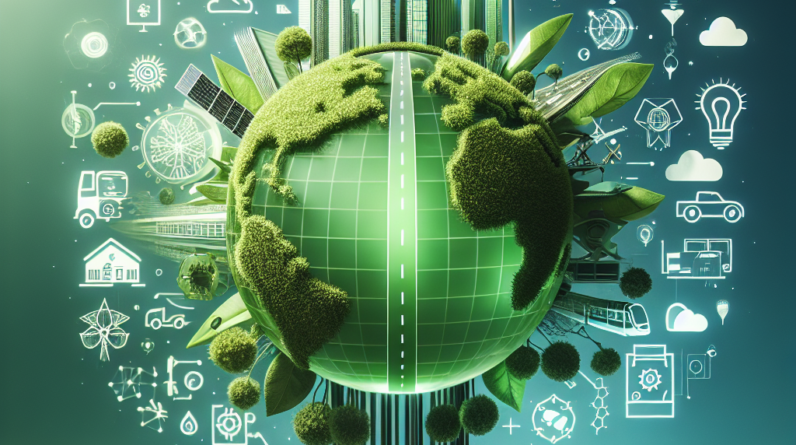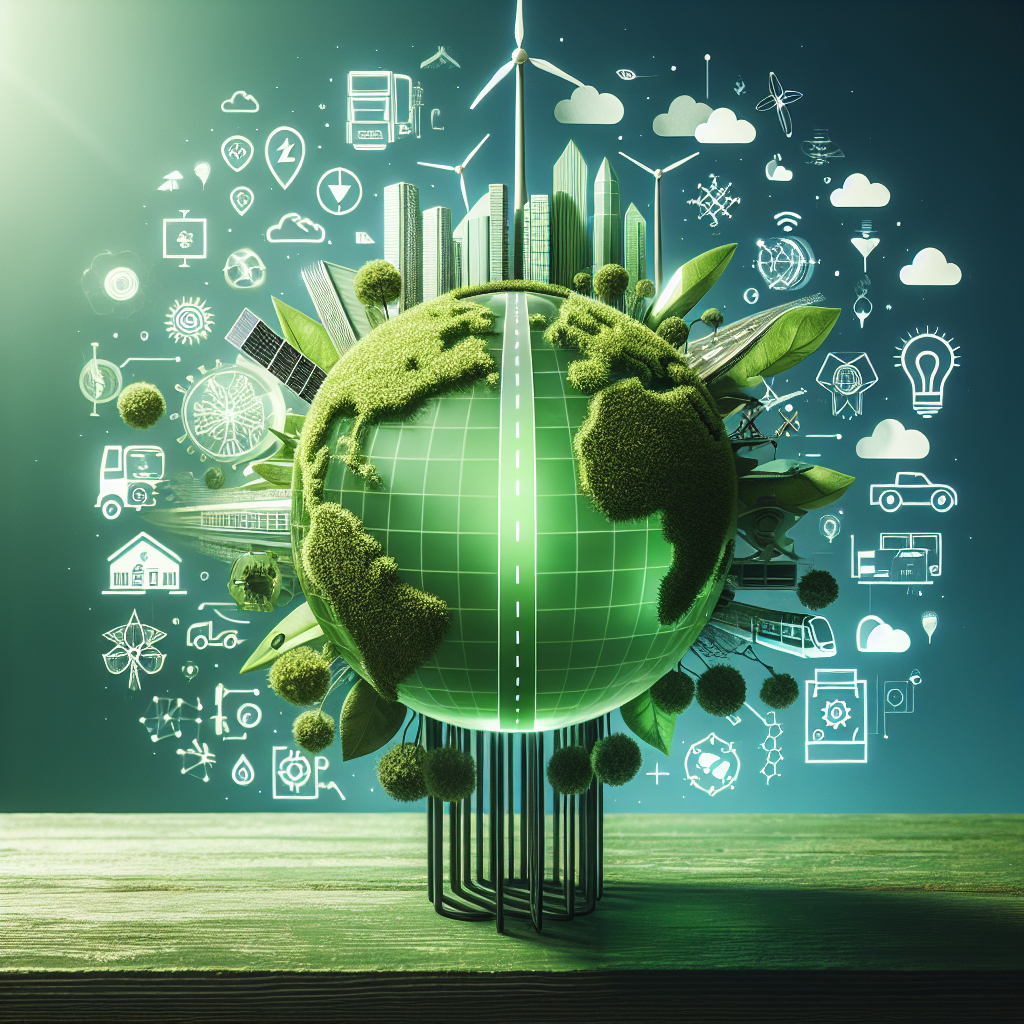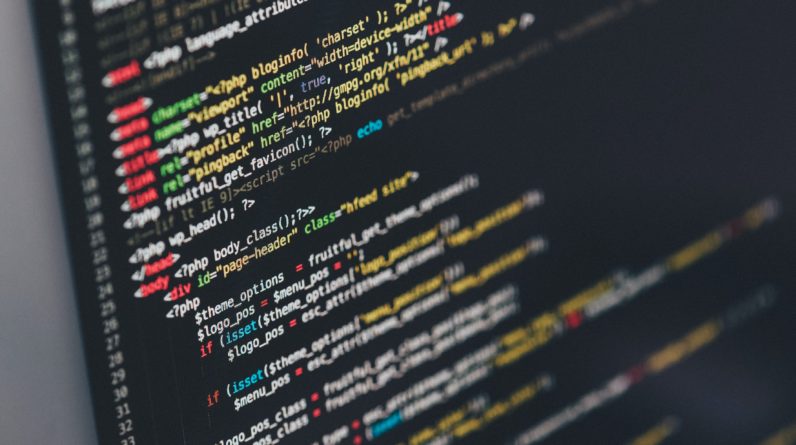
Green Tech Revolution: Pioneering a Sustainable Future
In this article, you will get a sneak peek into the exciting world of sustainable technologies set to make a big impact in 2024. The Green Tech Revolution is well underway, and innovative solutions are emerging to tackle environmental challenges. From advanced renewable energy systems to intelligent transportation, we will explore the top sustainable technologies that will shape the future and pave the way for a greener and more sustainable world. Get ready to be inspired by the cutting-edge advancements that will revolutionize our relationship with the planet.
Energy Generation
Solar Power
Solar power is one of the most promising sustainable energy sources that you should keep an eye on in 2024. By harnessing the power of the sun, solar panels can convert sunlight into electricity, providing clean and renewable energy. With advancements in technology, solar panels are becoming more efficient and affordable. They can be installed on rooftops, in large solar farms, or even integrated into the design of buildings. Solar power is a great way to reduce your carbon footprint and decrease reliance on fossil fuels.
Wind Power
Another exciting sustainable technology to watch in 2024 is wind power. Wind turbines can capture the kinetic energy of wind and convert it into electricity. They are typically installed in wind farms, located in areas with consistent and strong winds. As technology improves, wind turbines are becoming more efficient and able to generate more electricity. Wind power is a clean and renewable energy source that can help reduce greenhouse gas emissions and combat climate change.
Hydroelectric Power
Hydroelectric power has been around for a while, but advancements in technology are making it an even more enticing sustainable energy source in 2024. By harnessing the power of moving water, such as rivers or waterfalls, hydroelectric power plants can generate electricity. As water flows through the turbines, it spins them, generating clean and renewable energy. Hydroelectric power is reliable, as long as there is a continuous water supply, and it has the advantage of storing energy in the form of water, which can be released when needed. This makes it a flexible and sustainable option for energy generation.
Energy Storage
Battery Technology
One of the key challenges of renewable energy sources is their intermittency. The sun does not always shine, and the wind does not always blow. This is where energy storage technologies, like batteries, come into play. Battery technology has been rapidly advancing and becoming more affordable in recent years. Batteries can store excess energy generated from renewable sources and release it when the demand is high or when renewable sources are not available. In 2024, expect to see further developments in battery technology, with higher capacities and longer lifespans. This will lead to improved integration of renewable energy sources into the grid and greater energy independence.
Hydrogen Fuel Cells
Hydrogen fuel cells are another exciting energy storage technology to watch in 2024. Fuel cells generate electricity through a chemical reaction between hydrogen and oxygen, while only emitting water vapor as a byproduct. They can be used to power vehicles, homes, and even entire cities. In 2024, advancements in hydrogen fuel cell technology are expected to make them more efficient, affordable, and accessible. This will contribute to the transition to a clean and sustainable energy future.
Flywheel Energy Storage
Flywheel energy storage is a mechanical method of energy storage that involves spinning a wheel or flywheel at high speeds to store kinetic energy. When energy is needed, the flywheel slows down, releasing the stored energy. This technology is efficient, has a long lifespan, and is environmentally friendly. In 2024, flywheel energy storage is expected to become more widely implemented, with improved designs and higher energy storage capacities. It can play a significant role in stabilizing the electrical grid and increasing the reliability of renewable energy sources.
Transportation
Electric Vehicles
Electric vehicles (EVs) have gained significant traction in recent years and are set to become even more prevalent in 2024. EVs use electric motors powered by rechargeable batteries, eliminating the need for fossil fuels and reducing greenhouse gas emissions. With advancements in battery technology, EVs are becoming more affordable, have longer ranges, and charge faster. In 2024, expect to see a wider range of electric vehicle models on the market, making sustainable transportation options more accessible to the general public.
Hybrid Vehicles
Hybrid vehicles combine an internal combustion engine with an electric motor, offering improved fuel efficiency and reduced emissions compared to traditional vehicles. They can run on gasoline or electricity, depending on driving conditions and energy demands. In 2024, expect advancements in hybrid vehicle technology, resulting in more efficient and eco-friendly options. Hybrid vehicles will continue to play a vital role in the transition to sustainable transportation and reduce our reliance on fossil fuels.
Fuel Cell Vehicles
Fuel cell vehicles (FCVs) are powered by hydrogen fuel cells that convert hydrogen gas into electricity, with water vapor as the only byproduct. They offer the benefits of electric vehicles, such as zero emissions, but with the advantage of quick refueling times and longer driving ranges. FCVs are still in the early stages of development and commercialization, but in 2024, expect to see progress in infrastructure, with the establishment of more hydrogen fueling stations, and improvements in fuel cell technology. Fuel cell vehicles have the potential to revolutionize the automotive industry and play a significant role in creating a sustainable transportation system.
Hyperloop
The Hyperloop is a transportation concept that envisions high-speed travel in pods or capsules through low-pressure tubes. By eliminating air resistance and friction, the Hyperloop promises to be energy-efficient and capable of reaching incredible speeds. In 2024, expect to see further advancements in the development of Hyperloop technology, with prototype testing and potential implementation in certain regions. If successful, the Hyperloop could revolutionize long-distance travel, offering a sustainable alternative to air travel and reducing congestion on highways.
Smart Grid
Advanced Metering Infrastructure
Advanced Metering Infrastructure (AMI) refers to the collection of smart meters, communication networks, and data management systems that enable two-way communication between consumers and utility companies. Smart meters record energy consumption in real-time, allowing consumers to monitor and optimize their energy usage, while also providing valuable data for utility companies to manage the grid more efficiently. In 2024, expect to see further deployment of AMI, resulting in increased energy efficiency and smarter grid management.
Smart Meters
Smart meters are a key component of the AMI, providing consumers with real-time information about their energy consumption. They eliminate the need for manual meter reading and enable dynamic pricing models, where electricity rates vary based on time of use. Smart meters empower consumers to make informed decisions about their energy consumption, encouraging conservation and reducing peak demand. In 2024, expect to see the widespread adoption of smart meters, benefiting both consumers and utility companies.
Distributed Energy Resources
Distributed Energy Resources (DERs) are small-scale power sources, such as solar panels and wind turbines, that are installed closer to the point of consumption. These resources can generate electricity and contribute to the overall energy supply, reducing the reliance on centralized power plants. In 2024, expect to see the integration of DERs into the smart grid, allowing for more efficient and reliable electricity distribution. DERs can enhance grid resilience, reduce transmission losses, and promote the use of renewable energy sources.

Water Conservation
Smart Irrigation Systems
Smart irrigation systems use sensors and weather data to optimize watering schedules and minimize water waste in landscaping and agriculture. These systems can detect soil moisture levels, temperature, and rainfall to determine the precise amount of water needed. In 2024, expect to see the widespread adoption of smart irrigation systems, leading to significant water conservation and reduced water consumption in both residential and agricultural settings.
Greywater Systems
Greywater systems collect and treat wastewater from sources such as sinks, showers, and washing machines for reuse in irrigation, toilet flushing, and other non-potable uses. These systems help reduce water consumption by maximizing the use of water resources and decreasing the strain on freshwater supplies. In 2024, expect to see increased implementation of greywater systems in residential and commercial buildings, contributing to water conservation efforts and sustainable water management.
Rainwater Harvesting
Rainwater harvesting involves collecting rainwater from rooftops, surfaces, or other catchment areas and storing it for later use. This water can be used for irrigation, domestic purposes, or even treated for drinking water. Rainwater harvesting helps alleviate water scarcity issues, reduces the strain on public water supplies, and promotes sustainable water management. In 2024, expect to see increased adoption of rainwater harvesting systems, both at the individual and community level, as people recognize the importance of conserving water resources.
Waste Management
Recycling Technology
Recycling technology plays a crucial role in reducing waste and conserving resources. Advances in recycling technology have enabled the recycling of a wider range of materials, including plastics, metals, and electronics. In 2024, expect to see continued progress in recycling infrastructure and processes, resulting in increased recycling rates and reduced reliance on landfilling. Recycling is a key component of a circular economy, where resources are kept in use for as long as possible.
Waste-to-Energy
Waste-to-energy technologies convert waste materials into energy, such as electricity or heat, through processes like incineration or anaerobic digestion. These technologies help reduce the volume of waste sent to landfills while simultaneously generating energy. In 2024, expect to see advancements in waste-to-energy technologies, making them more efficient and environmentally friendly. Waste-to-energy can contribute to waste management strategies by diverting waste from landfills and providing a sustainable source of energy.
Composting Systems
Composting is a natural process that breaks down organic waste, such as food scraps and yard trimmings, into nutrient-rich compost that can be used as a soil amendment. Composting helps reduce the amount of organic waste sent to landfills, mitigates greenhouse gas emissions, and enhances soil health. In 2024, expect to see increased adoption of composting systems, both at the individual and community level, as people recognize the environmental benefits of diverting organic waste from landfills.

Green Buildings
Energy-Efficient Design
Energy-efficient design focuses on minimizing the energy consumption of buildings by incorporating features such as insulation, efficient windows, and energy-efficient appliances. These design principles can significantly reduce energy usage and greenhouse gas emissions associated with buildings. In 2024, expect to see the widespread adoption of energy-efficient design practices, with more buildings meeting or exceeding stringent energy efficiency standards. Green buildings can contribute to a more sustainable built environment and reduce the overall energy demand.
Renewable Energy Integration
Renewable energy integration in buildings involves the integration of solar panels, wind turbines, or other renewable energy sources into the building design. By generating clean and renewable energy on-site, buildings can reduce reliance on the grid and decrease carbon emissions. In 2024, expect to see increased integration of renewable energy technologies in buildings, resulting in greater energy self-sufficiency and reduced environmental impact.
Smart Building Automation
Smart building automation refers to the use of interconnected technologies, sensors, and machine learning algorithms to optimize building operations and energy efficiency. These systems can automatically adjust lighting, heating, and cooling based on occupancy levels and environmental conditions, leading to significant energy savings. In 2024, expect to see further advancements in smart building automation, with more buildings implementing these technologies to enhance comfort, reduce energy waste, and improve overall sustainability.
Circular Economy
Product Lifecycle Management
Product lifecycle management involves considering the entire lifespan of a product, from design to disposal. It aims to minimize waste generation and maximize resource efficiency by incorporating principles such as recycling, reusing, and remanufacturing. In 2024, expect to see increased adoption of product lifecycle management practices, as companies recognize the economic and environmental benefits of a circular economy. This transition will help reduce waste, conserve resources, and create a more sustainable and resilient economy.
Resource Recovery
Resource recovery involves extracting valuable materials or energy from waste streams. It includes processes such as recycling, composting, and anaerobic digestion. Resource recovery helps divert waste from landfills and contributes to a circular economy by reusing valuable materials. In 2024, expect to see advancements in resource recovery technologies, making them more efficient and economically viable. Resource recovery can play an essential role in waste management and sustainable resource utilization.
Reuse and Repurpose
The reuse and repurposing of products and materials are essential aspects of a circular economy. Instead of disposing of products after use, they can be repaired, refurbished, or reimagined for new purposes. This reduces waste generation, extends the lifespan of products, and reduces the demand for new resources. In 2024, expect to see a shift towards a more reuse-oriented society, with increased emphasis on product durability, repairability, and the development of reuse networks. Embracing reuse and repurposing can help create a more sustainable and resource-efficient future.

Sustainable Agriculture
Precision Farming
Precision farming involves the use of technology, such as GPS, sensors, and drones, to optimize agricultural practices and increase productivity while minimizing resource use and environmental impact. By precisely monitoring soil conditions, water needs, and crop health, farmers can apply fertilizers, pesticides, and water more efficiently. In 2024, expect to see further integration of precision farming technologies, resulting in increased crop yields, reduced chemical inputs, and improved sustainability in agriculture.
Vertical Farming
Vertical farming is a method of growing crops in vertically-stacked layers, such as in tall buildings or warehouses, using artificial lighting and controlled environments. This technique allows for year-round crop production, higher crop yields, and reduced land and water use. In 2024, expect to see increased adoption of vertical farming, particularly in urban areas, where space is limited. Vertical farming can contribute to food security, reduce transportation emissions, and promote sustainable agriculture.
Biopesticides
Biopesticides are derived from natural sources, such as bacteria, fungi, or plants, and are used to control pests and diseases in agriculture. Unlike conventional chemical pesticides, biopesticides are generally less harmful to the environment and have minimal impact on non-target organisms. In 2024, expect to see further research and development of biopesticides, with increased availability and adoption in agricultural practices. Biopesticides can contribute to sustainable pest management, reduce chemical exposure, and preserve ecosystem health.
Carbon Capture and Storage
Direct Air Capture
Direct Air Capture (DAC) technology involves removing carbon dioxide from the atmosphere and storing it underground or converting it into a useful product. DAC provides a means of reducing atmospheric carbon dioxide levels, mitigating climate change, and potentially producing carbon-neutral or negative emissions. In 2024, expect to see advancements in DAC technology, making it more efficient and cost-effective. DAC can play a crucial role in reaching net-zero emissions and addressing the challenges of climate change.
Carbon Sequestration Techniques
Carbon sequestration techniques aim to capture carbon dioxide emissions from power plants, industrial facilities, or the air and store it underground or in other long-term storage methods. This prevents carbon dioxide from being released into the atmosphere, reducing greenhouse gas emissions and the impact of climate change. In 2024, expect to see continued research and deployment of carbon sequestration technologies, with a focus on improving efficiency and scaling up operations. Carbon sequestration can contribute to the transition to a low-carbon economy and help achieve climate goals.
Carbon Utilization
Carbon utilization involves converting carbon dioxide emissions into useful products, such as fuels, plastics, or building materials. By capturing carbon dioxide and transforming it into valuable resources, carbon utilization offers a way to reduce emissions and create economic opportunities. In 2024, expect to see advancements in carbon utilization technologies, with increased deployment and commercialization of carbon capture and utilization facilities. Carbon utilization can contribute to the circular economy and pave the way for a sustainable carbon-neutral future.
In conclusion, the Green Tech Revolution is well underway, and sustainable technologies are set to transform various sectors in 2024. From energy generation to waste management and agriculture, innovative solutions are being developed to address environmental challenges and create a more sustainable and resilient future. By embracing these technologies and integrating them into our daily lives, we can collectively work towards a greener and more sustainable planet. So get ready to be a part of the Green Tech Revolution of 2024 and start exploring these sustainable technologies today!







